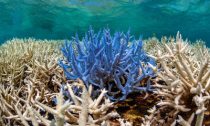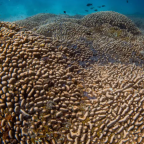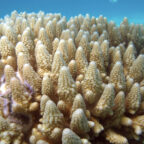
Marine biologist Ruth Gates sat down in an oversized wooden rocking chair at an oceanside resort here last week to talk about the next frontier in coral science and a new hope for saving coral reefs reeling from climate change: genetic technology.
“There are hundreds of species of coral, all with complex biologies and physiological traits that vary based on their DNA and environment,” Gates, director of the Hawaii Institute of Marine Biology, said while seated on a sprawling lanai overlooking acres of coral reefs awash in turquoise waters.
“Using genetic technology to identify corals resilient to environmental stressors may allow us to save corals – which are some of the most threatened organisms on Earth,” added Gates, a leading coral scientist who was featured in the new documentary “Chasing Coral.”
Coral reefs provide habitat to a quarter of the world’s marine species and are crucial sources of food and income to hundreds of millions of people. While corals are typically hardy creatures, rising ocean temperatures, acidification and pollution are harming corals on a scale not seen in recorded history. The world has lost about 50 percent of its coral reefs in just the past three decades, and in the next three decades it’s expected to lose more than 40 percent more. The unprecedented back-to-back coral bleaching events of 2014–17 devastated coral reefs worldwide.
According to Gates and other marine scientists, identifying both weak and resilient coral species is imperative to protect surviving reefs and help others recover. But cataloging corals with traditional visualization techniques can be challenging because even individuals belonging to the same species can be quite variable in appearance and react in different ways to the same environmental stressors.
Researchers at the University of Washington, led by doctoral student James Dimond, have attempted to make coral identification simpler and more accurate by using new genetic technologies. In a study published in the journal Molecular Ecology on August 12, Dimond’s group described how they sequenced coral genomes to determine if three distinct-looking individual corals belonged to three different species or one species with varying traits.
“If they are to be protected, we must be able to define a species,” said Dimond. “Genomes are huge – millions of letters – even for seemingly simple organisms like corals. Until pretty recently, we’ve only had the ability to look at a tiny, tiny fraction of an organism’s genome. The more the technology continues to advance, the deeper we are able to dig.”
In the past, scientists have analyzed just 10 or 11 genetic markers in the three coral specimens studied, some of which have long, slender branches, while others have short and knobby branches. That previous research suggested the corals belonged to the same species, Porites porites. Dimond and his colleagues used new rapid, high-throughput genetic sequencing technology to examine more than 1,000 sites on the organisms’ genomes and found more evidence that the three corals do indeed appear to belong to the same species, but vary in appearance.
With new genetic technologies, Dimond’s group also studied the corals’ epigenomics – genetic mechanisms that affect how an organism’s DNA can give rise to multiple variations of the same trait such as color or temperature resistance. The researchers focused on the epigenetic process of DNA methylation, in which a carbon-based methyl molecule binds to the DNA strand and affects how a gene gets translated into a protein that creates a physiological trait in an organism’s body.
The environmental factors responsible for switching certain traits on and off in organisms’ genomes are not well understood. But it appears that epigenetics affect not only an organism’s appearance but also its ability to survive stressors such as rising ocean temperatures. That’s critical information to know if a complete loss of reefs is to be avoided, according to Gates.
“Scientists’ goal right now should be to take the steps necessary to optimize coral species so that each successive generation is more resilient,” said Gates, who is two years into a five-year project aimed at doing just that.
Gates and her colleagues at the Hawaii Institute of Marine Biology selectively breed the most resilient corals and study the plants and bacteria that affect coral health. They are also investigating coral epigenetics – specifically, what happens to corals’ offspring when a coral is exposed to a specific environmental stressor. Gates said that the No. 1 threat to corals is climate change.
It’s scientists’ job, she said, to try to keep as many corals alive as possible. And that requires an urgent focus on genetics, selective breeding and coral replanting.
“These things we’re doing to help corals are a crutch and buy us time,” said Gates. “But if we don’t reduce our greenhouse gas impact, we’ll worry about our very survival on the planet. We’re not separate from this; we, too, will succumb to the stressors harming the most vulnerable creatures like corals.”















Social Profiles